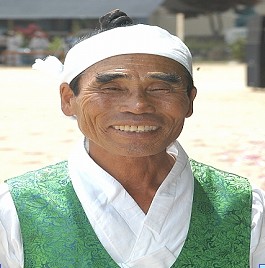금과들소리
| 금과들소리 |
|
 금과들소리(들소리)(이정호), 국가문화유산포털, 문화재청. |
|
| 대표명칭 | 금과들소리 |
|---|---|
| 한자 | 金果들소리 |
| 지정(등록) 종목 | 전라북도 무형문화재 제32호 |
| 지정(등록)일 | 2005년 3월 11일 |
| 분류 | 무형문화재 |
| 시대 | 조선시대 |
| 웹사이트 | 금과들소리(들소리)(이정호), 국가문화유산포털, 문화재청. |
해설문
국문
금과들소리는 15∼16세기 무렵부터 순창군 금과면 매우리 일대에서 논농사를 지으며 부르는 노동요이다. 동전 들녘과 대장 들녘 등에서 불렸으며, 농사짓는 고된 노동의 시름을 흥겨움으로 전환하고, 풍년을 기원하는 농민들의 긍정적이고 소박한 생활상이 담겨 있다.
금과들소리에는 1년의 논농사 과정이 들어 있다. 「물푸기 소리」, 「모찌는 소리」, 「모심기 소리」, 「김매기 소리」, 「장원질 소리」 등으로 이루어져 있으며, 선후창, 교환창, 제창 등 다양한 가창 방식을 섞어 부른다.
20세기 중반 농업기술이 기계화됨에 따라 공동으로 일하는 경우가 줄어들면서, 금과들소리 역시 점차 불리지 않게 되었다. 이를 안타깝게 여긴 지역 주민들이 1997년에 사라져 가는 농요를 채록 발굴하였으며, 현재 순창농요금과들소리보존회에서 계승 · 보존하는 데 힘쓰고 있다.
2005년에 전라북도 무형문화재로 지정되었고, 2007년에는 이정호(1940∼2017)가 예능 보유자로 인정되었으며, 매년 모내기 시기인 6월 둘째주 일요일에 정기 현장공연이 열리고 있다.
영문
Geumgwadeulsori (Farmers' Songs of Geumgwa)
Geumgwadeulsori are work songs sung while doing rice farming around the 15th-16th centuries in the Maeu-ri area in Geumgwa-myeon, Sunchang-gun. They were sung in ….. , changing the worry from the difficult labor of doing rice farming by alleviating it and it can be interpreted as the positive and simple everyday life of the farmers who wish for a good harvest year.
Farmers' Songs of Geumgwa contain one year of rice farming process. They consist of “Section about water draining”, “Section about picking rice seedlings”, “Section about rice seedling transplanting”, “Section about weeding”, and “Section about choosing the best farmer”, and they are sung by mixing various singing styles such as call-and-response, give and take singing, and chanting.
In accordance with the mechanization of agricultural technology in the mid-20th century, the cases of working together decreased, and Farmers' Songs of Geumgwa were gradually not sung. As this was unfortunate, the residents of this area started excavating records of missing farmer’s songs in 1997. Currently, the Farmer’s Songs of Sunchang Geumgwadeulsori Preservation Society is aiding the preservation of Farmers' Songs of Geumgwa in accordance with their original form as a foundation upon which they formed.
In 2005, Farmers' Songs of Geumgwa were designated as Jeollabuk-do Intangible Cultural Heritage and in 2007, Lee Jeong-ho (1940-2017) was recognized as a master of his valuable artistic skills. A performance is held on the second Sunday of June during the transplanting rice seedlings period each year.
영문 해설 내용
금과들소리는 15-16세기 무렵부터 순창군 금과면 매우리 일대에서 논농사를 지으며 부르는 노동요이다. 동전 들녘과 대장 들녘 등에서 불렸으며, 농사짓는 고된 노동의 시름을 흥겨움으로 전환하고 풍년을 기원하는 농민들의 긍정적이고 소박한 생활상이 담겨 있다.
금과들소리에는 1년의 논농사 과정이 들어 있다. 「물푸기 소리」, 「모찌는 소리」, 「모심기 소리」, 「김매기 소리」, 「장원질 소리」 등으로 이루어져 있으며, 선후창, 교환창, 제창 등 다양한 가창 방식을 섞어 부른다.
20세기 중반 농업기술이 기계화됨에 따라 공동으로 일하는 경우가 줄어들면서, 금과들소리 역시 점차 불리지 않게 되었다. 이를 안타깝게 여긴 지역 주민들이 1997년 사라져 가는 농요를 채록 발굴하기 시작하였다. 현재 순창농요 금과들소리보존회에서 금과들소리를 원형 그대로 계승하여 보존하는 데 힘쓰고 있다.
금과들소리는 2005년 전라북도 무형문화재로 지정되었고, 2007년에는 이정호(1940-2017)가 예능 보유자로 인정되었다. 매년 모내기 시기인 6월 둘째 일요일에 공연이 열리고 있다.
참고자료
- 순창농요 금과들소리, 한국민족문화대백과사전, 한국학중앙연구원. http://encykorea.aks.ac.kr/Contents/Item/E0072764
- ‘금과 들소리, 한국민속대백과사전, 국립민속박물관. https://folkency.nfm.go.kr/kr/topic/detail/631
- 금과들소리, 디지털순창문화대전. http://sunchang.grandculture.net/sunchang/toc/GC05900821
- 풍요로운 들녘을 울리는 농요, 금과 들소리, 디지털순창문화대전. http://sunchang.grandculture.net/sunchang/toc/GC05900003
- 금과들소리(들소리), 국가문화유산포털, 문화재청. http://www.heritage.go.kr/heri/cul/culSelectDetail.do?ccbaCpno=2223500320000